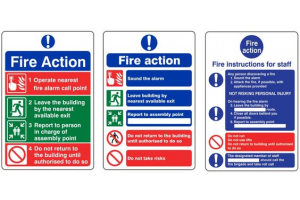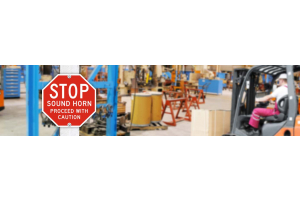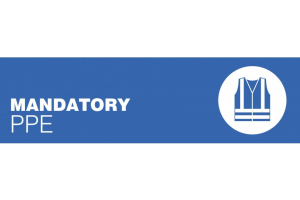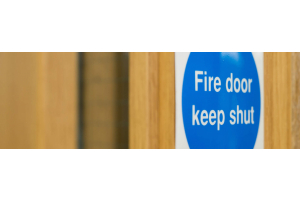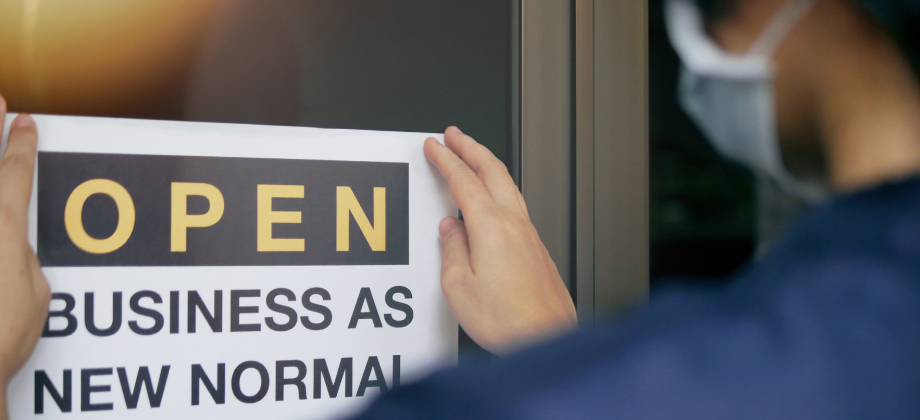
What does a business need to do to protect their staff? keep reminding your staff and customers to wear face masks in any indoor areas or where required by law, for example using signage as a reminder. Business owners are not responsible for making sure customer wear face coverings but you can take appropriate steps to make sure customers know they need to wear a face covering, this is a vital reminder to help reduce transmission especially when your customers are going to be around other people they don't normally meet.
Ensure everyone is social distancing, make it simple for everyone to do so by installing signage or laying down floor signs for people to follow such as creating a one way system and also think about the ventilation around the premises, encourage staff to take part in NHS Test and Trace and keep a record of staff, contractors and visitors for 21 days. Anyone with coronavirus symptoms should be turned away and If a member of staff, someone in their household or a visitor has a continuous cough, an unusually high temperature or lost their sense of taste or smell then they need to be isolating and you must not ask someone who is being requested to self-isolate to attend work and if an employer is asking an employee to stop self-isolating to return to work is committing an offence.
Where you already use personal protective equipment at work you must continue to do so but with the risk of coronavirus additional PPE more than what you normally use may be required by your employer, try and work with the same team everyday such as fixed teams and introduce shift patterns to help reduce the number of staff coming into contact with each other, think about using barriers between work areas or you could encourage staff to work side by side or back to back, try and reduce the number of deliveries you have and lower the number of times two people are required to lift and carry goods together but try and use the same people for the task to help reduce mixing staff members together. Try and make sure music or background noise is minimised to help stop people from speaking loudly or having to shout and ensure all of your staff are being kept informed of any safety measure being introduced and implemented so you can all work together to achieve the common goal.
This article provides guidance on opening workplaces safely whilst minimising the risk of spreading COVID-19 and provides considerations of how this can be implemented into the workplace and different businesses will need to take their own specific actions as required depending on the nature of the business such as the size and type of business, how it's being operated and managed as well as monitoring the measures implemented to ensure you protect visitors, staff and contractors.
Thinking about the risks
All employers have a legal responsibility to protect their staff, visitors and contractors from risk to their health, safety and well-being which includes the risks from COVID-19 which is a hazard around the workplace and needs to be managed just like any other hazard so you need to carry out a risk assessment of the potential risks of COVID-19 around the workplace to identify and introduce control measures to ensure the risk is managed. Failure to carry out a risk assessment and implement control measures as required might be seen as a breach of the health & safety law. The enforcing authority is the HSE or your local authority and if they identify businesses not complying with control measures they can take action action to ensure business owners comply by issuing improvement notices to ensure specific actions are carried out to improve workplace risks.
The risk assessment you carry out is designed to help you in making sure you have carried out everything you need to do. You should also think about the security measures of the decisions and control measures you are putting in place as revisions may make new or changed security risks that might need mitigation, should you have less than 5 workers, or self-employed you don’t have to document the findings as part of your risk assessment but it will be beneficial to do so. Business owners are required to respond to any improvement notices issued from the enforcing authorities fast and need to do so in the time frame requested by the enforcing authorities. Most business owners are responsible and will join with the UK’s fight against COVID-19 by working alongside the government and their sectors to help protect their staff and the public but inspectors continue to carry out compliance checks nationwide to make sure business owners are taking the appropriate actions.
Business owners are responsible for reducing workplace risks to the lowest practicable level by implementing preventative measures and all staff need to work with any other employers or contractors sharing their place of work to ensure everyone's health and safety is protected, businesses and workplaces must make every effort to make sure their staff can work in a safe manner and where possible staff should be encouraged to work from home and where staff are required to attend the workplace it is vital that they work with their employers by keeping to the COVID-19 safety guidelines their employers have introduced such as the social distancing guidelines as set out by the UK government.
Should social distancing measure be difficult to meet for a particular activity then try thinking about a new way to carry out the task to help staff keep a 2 metre distance or 1 metre plus if 2 metres is not possible, additional mitigating actions can include:
- increasing the hand washing and surface cleaning times
- keep the task as short as possible
- Introduce barriers or screens to separate people
- using back-to-back or side-to-side working (rather than face-to-face) whenever possible
- lowering the number of staff each person comes into contact with by having teams
In the event social distancing measures cannot be complied with even after changing the working method business owners need to think about the activity and whether or not it is viable for the business to operate and if yes ensure all mitigation's actions to help reduce the risk of transmission between workers.
Introduce actions to stop people from having to raise their voices or having to shout such as not playing loud music which people may shout over as this will increase the risk of transmission of the virus, if staff need to work face-to-face for a long period then assess whether or not if it is safe to carry out the activity as nobody should be forced to work in an unsafe environment. When you carry out the risk assessment take into consideration anyone who may be vulnerable to COVID-19. If your business is currently in operation you will will have already carried out an assessment of the risks posed by COVID-19 within your workplace and you can review this risk assessment to identify any further improvements you may need to make and you need to review the measures in place to ensure they are working, you also need to review the measures if they are no longer effective or if any changes in the workplace are leading to new levels of risks and You need to share the findings of your risk assessment with your staff.
Minute airborne particles can reach further than droplets and in poorly ventilated areas this could lead to viral particles spreading between people so it's important to have good ventilation which can help reduce this risk and good ventilation will differ for spaces depending on the number of people in the area and how it is used as well as the layout so careful consideration is required for ventilation.
Coming to and leaving work
It is vital to maintain social-distancing measures where possible this includes arriving and departing the workplace and to make sure hand washing upon arrival is carried out, having staggered arriving and leaving times from the workplace to reduce gathering should be taken into account, providing extra parking areas and bike racks to help people walk, run, or cycle to work where possible. Introduce a limit on the number of passengers in business vehicles such as minibuses such as leaving seats empty and minimise congestion by having extra entry points to the workplace and provide hand washing facilities or hand sanitiser at entry and exit points and avoid using touch-based security devices such as keypads. Using markings and introducing one-way flow at entry and exit points.
Minimise movement of non-essential trips within the workplace and buildings such as prohibiting access to areas and promoting the use of radios or phones and ensure cleaning them after being used and Introduce extra one-way flow systems through different buildings and lower the maximum occupancy for lifts as well as providing hand sanitiser for the operation of lifts and encourage the use of stairs but ensure sure that people with disabilities are able to access lifts, minimise the number of people in vehicles such as shuttle buses and carefully manage the use of high pedestrian traffic areas such as corridors, lifts, turnstiles and walkways to maintain social distancing.
Workplaces and workstations
The objective is to uphold social-distancing between between people whilst at their workstations, for staff who work in one place, workstations should allow them to maintain social-distancing where possible and workstations need to be allocated to single staff if possible but if they need to be shared with other staff the number must be kept to a minimum but if this is not possible you must ensure social distancing guidelines are met or consider whether the activity should continue for the business to operate, if yes ensure all mitigating actions are in place to reduce the risks of transmission. Steps that can be taken are looking at the layouts to change to try and make sure staff can work further apart from each other and consider using floor tapes or floor paint to mark off areas to help your employees comply with social distancing guidelines (2m, or 1m with risk mitigation where 2m is not viable), where possible avoid people working face to face by working side-by-side or facing away from each other and consider using screens to create a physical barrier between people.
Meetings
The objective is to reduce transmission from face-to-face meetings and uphold social-distancing in meetings and the steps to consider are using remote equipment to avoid in-person meetings and ensure only absolutely necessary people should physically attend meetings whilst maintaining social distancing guidelines and avoid the possibility of transmissions during the meetings such as sharing pens and documents, ensure hand sanitiser is readily available and if possible hold the meetings outdoors or in well ventilated rooms, where meeting rooms are the regular rooms use floor signage to ensure social distancing is maintained.
Common areas
The objective is to maintain social-distancing whilst using any common areas and steps to consider are break times can be staggered to reduce crowding in staff rooms or canteens and ensure social distancing is always met, try to encourage staff to take breaks outdoors, install screens for the receptionist and other areas, change the layout of canteen tables and chairs to provide larger distances between each to help reduce transmission and ask staff to stay on site during breaks to reduce the possibility of transmission from other places they are visiting, introduce some form of social distance marking for other common areas such as toilets, showers, lockers and changing rooms and in any other areas where queues are likely to form.
Before you re-open
The objective is to ensure that any premises that has been closed or partially open is thoroughly clean and sanitised and the steps to consider are checking if the ventilation system works well or needs servicing, keeping the workplace clean is essential especially where surfaces and objects have been touched so frequent cleaning is essential for items such as door handles, chairs, printers and other objects which require touching. Good hygiene is vital so encourage all staff, visitors, contractors and the general public to maintain hygiene levels and this can be done by installing signs and posters which promotes hand washing and sanitising, avoid touching your face and where people sneeze or cough make sure they use a tissue and dispose of it in a closed lid bin, provide extra hand sanitisers around the areas especially around toilets and washrooms and step up cleaning schedules for busy areas.
Personal protective equipment (PPE)
If you are already wearing personal protective equipment at work to protect you from non-COVID-19 risks you need to continue in doing so. COVID-19 is a special kind of risk different to the risks you will normally face in a workplace and has to be managed through hygiene and social distancing and not through the use of ppe, if you are working where the risk of COVID-19 transmission is very high the risk assessment needs to consider the fact that the role of PPE in providing extra protection is limited. However, if your risk assessment proves that PPE is required then you need to provide this PPE or free to staff who need it and all PPE provided must fit correctly. Face masks are not to be considered as a way of managing risks but increased hand washing, cleaning of objects and sanitising are the best way to manage risks for the purpose of health & safety assessments,. A face mask can be very effective and may be worn in enclosed spaces where social distancing isn’t possible and it only needs to cover your nose and mouth and is different from a face mask such as the surgical masks or respirators used by health care sector. However, face coverings are not the same as the PPE used to manage risks like dust and spray in an industrial context. Supplies of PPE, including face masks, must continue to be reserved for those who need them to protect against risks in their workplace, such as care workers, or for protecting against dust hazards in industrial settings, face coverings are a mandatory requirement on public transport and in a number of indoor premises, including visitors to storage and distribution facilities. Business owners must support their staff in using face coverings safely if they choose to wear one which means telling staff to;
- wash your hands thoroughly with soap and water for 20 seconds
- use hand sanitiser before putting a face covering on, and before and after removing it
- when wearing a face covering, avoid touching your face or face covering, as you could contaminate them with germs from your hands
- change your face covering if it becomes damp or if you’ve touched it
- continue to wash your hands regularly
- change and wash your face covering daily
- if the material is washable, wash in line with manufacturer’s instructions. If it’s not washable, dispose of it carefully in your usual waste
- practise social distancing wherever possible
Always be mindful that wearing of a face mask might inhibit communication with other people who rely on lip reading, facial expressions and clear sound.
